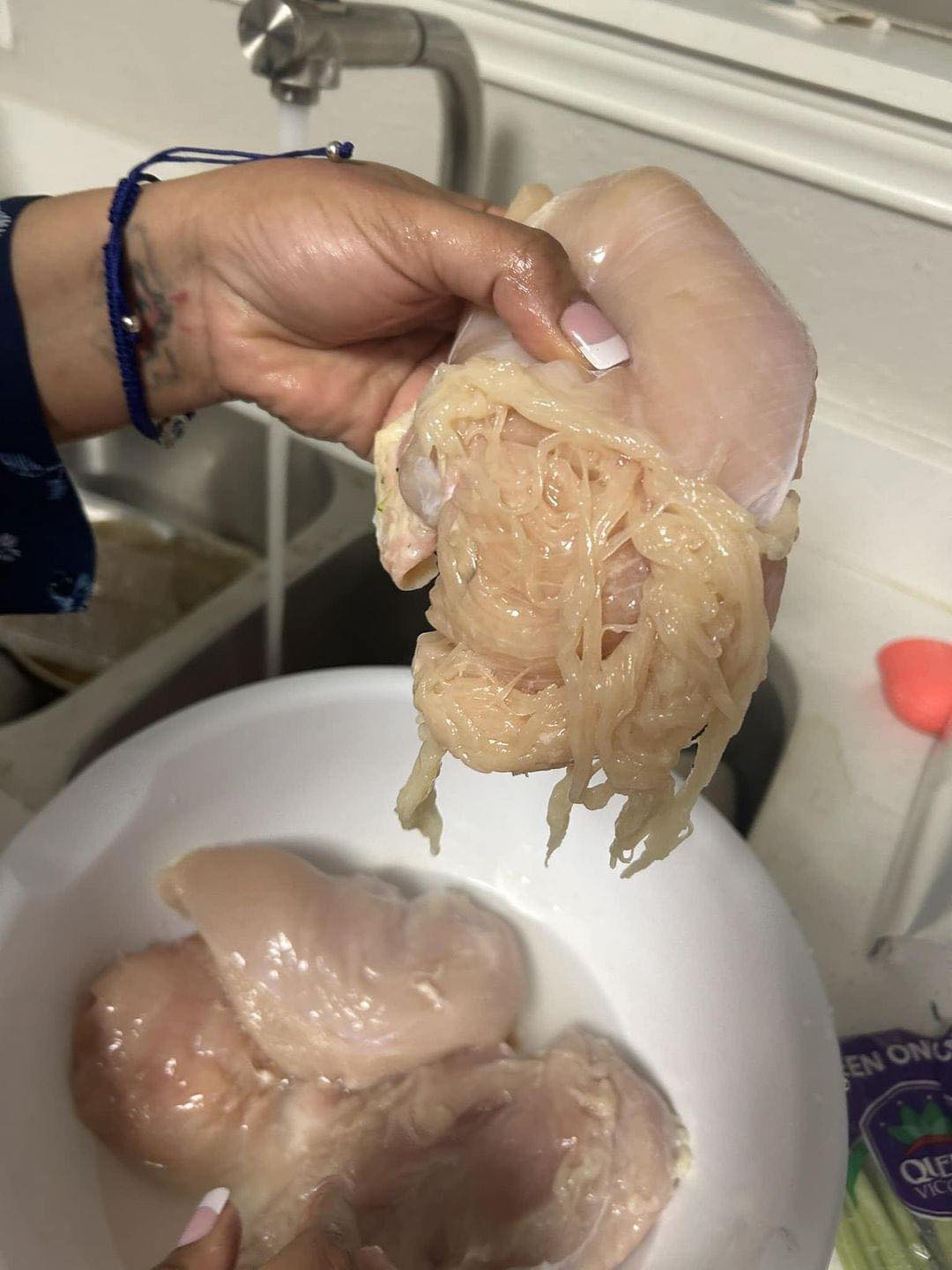A mother preparing dinner for her family was left stunned when the chicken breast she was rinsing began to disintegrate into strands resembling spaghetti. Her shocking experience, shared in a Facebook post alongside unsettling photos, has since gone viral, sparking widespread discussions and raising questions about the quality and origins of store-bought chicken.

“I think it’s some kind of imitation meat,” wrote Alesia Cooper, a resident of Irving, Texas, in her now-famous post. On March 21, Cooper shared her unusual find, starting her post with, “I wasn’t sure if I should share this, but if I had to see it, so should all of you.” Accompanying her words were images of chicken breast shredding into spaghetti-like strands as she handled it. She described how the bizarre discovery unfolded: “A few weeks ago, while preparing dinner for my kids, I washed the meat as I normally do. But when I returned to continue cooking, it had turned into this.”
Cooper mentioned purchasing the chicken from Aldi, a popular budget supermarket chain. “I think it might be imitation meat, but I’m not completely sure. I haven’t cooked chicken off the bone in a while,” she added, expressing confusion about the product.
Social media users flooded the comments section with a range of theories. Some speculated that the meat was lab-grown or even 3D-printed. “That’s lab-grown chicken,” one user claimed. “They’re introducing it in response to bird flu and resource shortages. Last year, they announced a way to create chicken in labs, and now it’s in stores.” Another user dismissed the product as “GMO lab meat,” while others declared they had stopped buying such chicken entirely, calling it “fake.”
Not everyone bought into these theories. One commenter suggested the issue stemmed from real chickens subjected to growth hormones. “This isn’t lab-grown or 3D-printed meat. It comes from actual chickens. The problem is that poultry producers pump them with hormones to make them grow too quickly,” the commenter explained.
According to The Wall Street Journal, the phenomenon Cooper encountered is known as “spaghetti meat.” This condition, along with another called “woody breast,” is linked to the breeding of chickens to grow larger and faster. These abnormalities often occur in chickens bred for higher meat yields, boosting profits for poultry producers. Dr. Massimiliano Petracci, an agriculture and food science professor at the University of Bologna, confirmed to the Journal that these conditions result from the rapid growth of certain chicken breeds.
While terms like “spaghetti meat” and “woody breast” sound unappetizing, experts assure consumers that these conditions are not harmful to human health. However, the rapid growth of chickens comes at a cost to the animals. Their oversized bodies put significant strain on their legs, making their short lives physically taxing and raising ethical concerns about their welfare.
Statistics from the National Chicken Council illustrate the dramatic changes in broiler chicken growth over the years. In 2000, the average broiler weighed 5.03 pounds at 47 days old. By 2023, chickens of the same age averaged 6.54 pounds. This growth is even more striking compared to 1925, when it took broilers 112 days to reach a market weight of just 2.5 pounds.
This trend reflects growing consumer demand for chicken, particularly breast meat. Dr. Michael Lilburn, a professor at Ohio State University’s Poultry Research Center, explained to The Washington Post that the industry has prioritized breeds with larger breasts to meet consumer preferences. “As chicken consumption continues to rise, we’ll likely see even larger chickens in the future, with an emphasis on increasing the proportion of breast meat per bird,” he said. “Most Americans remain indifferent to how their food is produced as long as it’s affordable.”
Fast-food chains and supermarkets contribute to this demand by offering low-cost chicken products like nuggets, wings, and sandwiches. However, some retailers are pushing back, advocating for “slow-growth” chickens that are given more time to mature. Proponents of this approach argue that it improves animal welfare and results in better-tasting meat.
Meanwhile, social media users have reacted with a mix of disgust and calls for change. “It looks like worms! What are they feeding us?” one person exclaimed. Another recalled a similar experience, lamenting, “This isn’t like the chicken we used to have when we were younger.”
Many commenters suggested alternatives to factory-farmed chicken. “You can get higher-quality chicken at local butcher shops or cooperatives,” one person advised. “I recommend checking those places for your meat.” Others declared the incident a turning point for their dietary habits. “I’m going vegan! There’s too much lab-made food out there,” one commenter said, while another announced, “This is why we’re switching to a pescatarian diet.”
Beyond individual reactions, Cooper’s post has reignited conversations about factory farming and its impact on animals and the food supply chain. Critics argue that the system prioritizes profit and efficiency at the expense of animal welfare and food quality. As one commenter noted, “It’s heartbreaking what these animals endure just to meet our demand for cheap food.”
Cooper’s discovery has left many questioning their food choices and the processes behind meat production. Whether this incident sparks long-term changes in consumer habits or industry practices remains to be seen. What’s your take on this unusual discovery? Share your thoughts and help expand the conversation.





